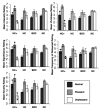Retrieval of emotional memories
- PMID: 17723029
- PMCID: PMC2265099
- DOI: 10.1037/0033-2909.133.5.761
Retrieval of emotional memories
Abstract
Long-term memories are influenced by the emotion experienced during learning as well as by the emotion experienced during memory retrieval. The present article reviews the literature addressing the effects of emotion on retrieval, focusing on the cognitive and neurological mechanisms that have been revealed. The reviewed research suggests that the amygdala, in combination with the hippocampus and prefrontal cortex, plays an important role in the retrieval of memories for emotional events. The neural regions necessary for online emotional processing also influence emotional memory retrieval, perhaps through the reexperience of emotion during the retrieval process.
PsycINFO Database Record (c) 2007 APA, all rights reserved
Figures



References
-
- Addis DR, Moscovitch M, Crawley AP, McAndrews MP. Recollective qualities modulate hippocampal activation during autobiographical memory retrieval. Hippocampus. 2004;14:752–762. - PubMed
-
- Adolphs R, Gosselin F, Buchanan TW, Tranel D, Schyns P, Damasio AR. A mechanism for impaired fear recognition after amygdala damage. Nature. 2005 January 6;433:68–72. - PubMed
-
- Adolphs R, Tranel D, Damasio H. Emotion recognition from faces and prosody following temporal lobectomy. Neuropsychology. 2001;15:396–404. - PubMed
-
- Anderson AK, Spencer DD, Fulbright RK, Phelps EA. Contribution of the anteromedial temporal lobes to the evaluation of facial emotion. Neuropsychology. 2000;14:526–536. - PubMed
Publication types
MeSH terms
Grants and funding
LinkOut - more resources
Full Text Sources
Other Literature Sources

